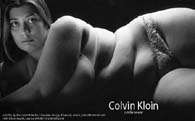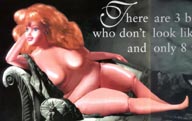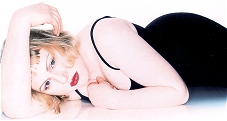- “Humanity has lost its dignity; but art has rescued it and preserved it in significant stone. Truth lives on in the illusion of art, and it is from this copy, or afterimage, that the original image will once again be restored.”
- -Schiller, Letters on the Aesthetic Education of Man.
Despite Alphonse Karr’s cynical adage (“Plus ça change, plus c’est la même chose”), aesthetic values are changing—and feminine aesthetics are changing with them. Just as the burgeoning interest in nineteenth-century painting indicates that we have tired of “ugliness chic” and seek the return of beauty in the arts, so do we yearn for the reappearance of true feminine beauty. At long last, the media’s androgynous “ideal” is eroding.
This page celebrates some brave artists and entrepreneurs who are at the forefront of this aesthetic restoration. I say “restoration” rather than “revolution” because—as other pages on this site demonstrate—the growing veneration of the fuller figure does not represent the introduction of a new standard of feminine beauty, but a return to the timeless ideals that held sway in Western culture in every century prior to the twentieth. How fitting that, as the new millennium dawns, we are rediscovering our culture’s aesthetic heritage, and reclaiming it for our own.
ELENA MIRÒ 2001 BARBARA BRICKNER CALENDAR

The “Lane Bryant of Italy,” Elena Mirò operates stores in every Italian city and throughout the rest of Europe. But what makes this company so special is that it takes very seriously its mission to redefine public perceptions of feminine beauty. Nothing more clearly demonstrates this than its choice of Barbara Brickner to serve as the company’s official “face.” Since being selected to represent Elena Mirò to the world, Mrs. Brickner has graced the covers of the company’s catalogues, advertisements, magazines, and even a recently-published book chronicling Elena Mirò’s history, called Ciao, Magre! (which, loosely translated, means “Take a hike, starving waifs!”).
But for 2001, Elena Mirò has outdone itself by releasing a gorgeous, not-to-be-missed Barbara Brickner Calendar, featuring twelve unforgettable images of the model wearing the most feminine and sensual attire imaginable (and yes, even swimwear).
Anyone who wishes to see just how radical and exciting this calendar is can view it in standard format in the fifth Barbara Brickner gallery, or download it as a screensaver, here. The file is a full 1.3 Mb, but the results more than justify the lengthy download time. The original photo shoot took place in exotic St. Tropez, on the Côte d’Azur, and Elena Mirò is promoting this calendar with the following very affirmative statement (which sounds even better in the original Italian):
The Millennium changes, lifestyles change, women change. The Third Millennium mainly brings about a new way to be beautiful. We were the first to have the pleasure to express this change. Elena Mirò has chosen a woman to interpret a new, splendid ideal of beauty—certainly sensual and attractive, extraordinarily lovely and sunny—in this calendar. We dedicate the Third Millennium to her.
The company also proudly lists the model’s precise measurements in a graphic on the reverse of the calendar: 104cm-84cm-114cm (or, in inches, 42-34-46).
This calendar is the most perfect example of size celebration yet created, and one can only hope that Elena Mirò’s creative effots will inspire many others to follow its lead in promoting fuller-figured femininity through the power of such indescribably beautiful images.
MARKS & SPENCER “I’M NORMAL” T.V. COMMERCIAL


In Britain and its former colonies, the name Marks & Spencer has long been synonymous with fashion, much as Bloomingdale’s has been in the United States. So powerful was Marks & Spencer’s reputation for quality that until recently, the company considered advertising unnecessary. But demographic shifts and an increasingly unfashionable image resulted in M&S losing more than half of its business over the last few seasons, and pundits predicted that the sun was finally setting on the venerable retailer.
But they failed to reckon with the power of plus-size beauty—in particular, that of size-16 model Amy Davis (above). Marks & Spencer hired famed advertising guru M.T. Rainey to spruce up the company’s image, and the result was a £100,000 television ad featuring Ms. Davis doffing all her clothes while running up a hillside. (You may read the full story here.) The ad concludes with a daring but tasteful shot of Ms. Davis in the buff, standing atop the hill and shouting, “I’m normal!”
Since its September 2000 debut, this ad has become one of the most talked-about British media events of the year—and no wonder. Rainey herself says that she and her client “wanted to make a statement that would show women as being confident and beautiful. It’s a lovely, celebratory image.”
It certainly is, and its symbolism is unmistakable. A gorgeous plus-size model memorably casts aside the burden of twentieth-century “ugliness chic,” and lets the world see genuine feminine beauty in all its full-blown splendour. In doing so, she rescues a famed British institution with a history extending back to the Victorian era. The aesthetic restoration continues…
COLVIN KLOIN AD

This unsubtle challenge to the most notorious promoter of the androgynous ideal (who can forget Calvin Klein’s loathsome “heroin chic” campaign?) appeared in the July 23, 2000 edition of a Seattle newspaper. It is the work of a local body image artist named Therese Stowell, featuring gorgeous model Josie Bockelman. Apparently, Stowell’s attempts to place the ad on buses and billboards were denied by a Seattle media concern—indicating how deeply entrenched media stereotypes remain.
Reactions to the ad tend to follow a common pattern: at first, viewers are stunned by its originality, but this is quickly replaced by a growing appreciation (and finally, unrestrained adulation) of the model’s enthralling beauty.
Special thanks to Ms. Stowell herself for providing me with this computer image of her ad. You may read the transcript of a Seattle television news report about her efforts here.
BIJAN’S “BELLA” ADS

Famed Los Angeles clothier and perfumer Bijan’s triptych of ads featuring “Bella,” an unknown model, initially faced stiff resistance from the New York establishment, for reasons that no one dared to admit to him. However, once Talk magazine’s editor-in-chief Tina Brown accepted the ads, other glossies quickly followed suit. Bijan himself states that the images were created as an homage to the “unique colorful style and simple magnificence” of the work of several famous artists of the past. And most significantlyly, as L.A. Times journalist Barbara Thomas reported when the ads debuted, “Bijan did not create the campaign as any political statement…‘I am an artist,’ he said. ‘I did that because [Bella] was beautiful and inspired me.’”
Like Therese Stowell’s Colvin Kloin ads, these Bijan images more successfully demonstrate the beauty of fuller-figured femininity than any long-winded treatise on “size acceptace” ever could.
You can see the rest of the campaign and read related news stories at the Bijan Web site: www.bijanfragrances.com/bella.htm.
THE BODY SHOP AND “RUBY”


A few years ago, iconoclastic British retailer The Body Shop organized a very well-received campaign of size celebration. The centrepiece of this promotion was an image of a plastic doll, which they named “Ruby” (with deliberate “Rubenesque” connotations), accompanied by the clever caption, “There are three billion women who don’t look like supermodels, and only eight who do.” The throngs who bombarded Body Shops around the world with requests to purchase this doll were sadly disappointed to find that no such doll actually existed. Alas, she was only a computer-generated image. But what an image! To this day, Ruby remains the epitome of size celebration—she is ravishingly beautiful, blissfully happy, and unreservedly proud of her opulent figure. The self-assured attitude that she radiates is one that all plus-size models should aspire to project. Place her image beside any skeletal Barbie doll, and watch the emaciated waif fade into insignificance.
NICK KNIGHT AND THE BRITISH BLONDES

Even before the Omega corporation pulled its advertising from British Vogue to protest its use of anorexic-looking models (bravo!), iconoclastic photographer Nick Knight was already planning to detonate a bomb in the world of high fashion by shooting models in the forbidden sizes (i.e., 14 and up). The first of his latter-day “British Blondes” was Sophie Dahl, but Knight was disappointed to find that the the size-14 granddaughter of novelist Roald Dahl wasn’t as full-figured as he hoped she would be. So, with the aid of a computer program, he digitally increased Miss Dahl’s curves in his photographs to make her body appear “more sensuous than it actually is.”
But Knight’s next discovery needed no artificial enhancement. After conducting a two-year search for his ideal model (whom he envisioned along the lines of women in great paintings of a bygone era), Knight finally located the perfect goddess-to-be—a size-16 fashion student named Sara Morrison. After doing an experimental shoot with Miss Morrison that put her image on the cover of a British contemporary-music single, Knight and Miss Morrison made fashion history with their June 1997 British Vogue layout entitled “Modern Curves.” This spread did for Britain and the Continent what MODE magazine did for North America—restore the concept of femininity to the fashion world. Miss Morrison promptly signed a lucrative contract with the Excel Models agency, and was soon doing high-calibre work throughout Europe.
And lest anyone doubt the sincerity of his work, Nick Knight proudly declares that his own wife “is Sara’s shape.”
MODE MAGAZINE
THE TOP FOUR COVERS:




I say without any hesitation whatsoever that the launch of MODE magazine remains the greatest and most significant event in the progress of the aesthetic restoration, thus far. There have been and continue to be other magazines devoted to larger women, but their impact on society has been negligible. MODE succeeded where others failed for one, simple reason—like Bijan in his Bella ads, MODE prioritized aesthetics over politics.
Instead of lengthy articles trying to “explain” the moral/political reasons why the media perpetuates size discrimination, MODE created a world in which plus-size women are revered. Instead of telling its audience that larger women can look desirable, MODE proved it by showing curvaceous models in form-fitting attire—yes, even in swimsuits and tasteful lingerie (no ridiculous boas!). And most importantly, instead of preaching about the attractions of the fuller figure and then showing images of ordinary-looking, average women in its photo spreads, MODE held its models to high aesthetic standards. MODE recognized that not every woman who wears a double-digit dress size can (or should) be a model, but that beautiful plus-size women easily outshine even the most attractive of thin women, as long as they are presented in all their glory.
The women in MODE women did not drape themselves in bargain-basement fashions, but sported haute couture designs that made their starving sisters green with envy. MODE women were both elegant and vibrant. MODE girls had poise, grace, class…and limitless sex appeal. And they never denied themselves any pleasures.
MODE’s creators devised the perfect formula for a plus-size-fashion glossy when they launched this magazine, and its absence will be felt for years.
Even among those who purport to champion “size acceptance,” we still encounter much trepidation about showcasing images of voluptuous women. The most notorious examples are the plus-size-clothing retailers who obstinately use minus-size models in their catalogues. But besides these offenders, many organizations that criticize media stereotypes still reproduce the very same media images that they condemn (albeit in order to critique them), rather than presenting an alternative. A current Kellogg’s promotionn claims to challenge the “cult of thinness,” but significantly, it does so by displaying out-of-shape men rather than fuller-figured women. The merits of such negative ad campaigns are highly questionable.
The intention of this page is to advocate a healthier and more natural approach to size celebration. Beautiful images of plus-size women speak for themselves, and are far more potent and positive weapons in the aesthetic reformation than any degree of condemnation. As the old saying goes: a .jpg is worth a thousand .txts!
